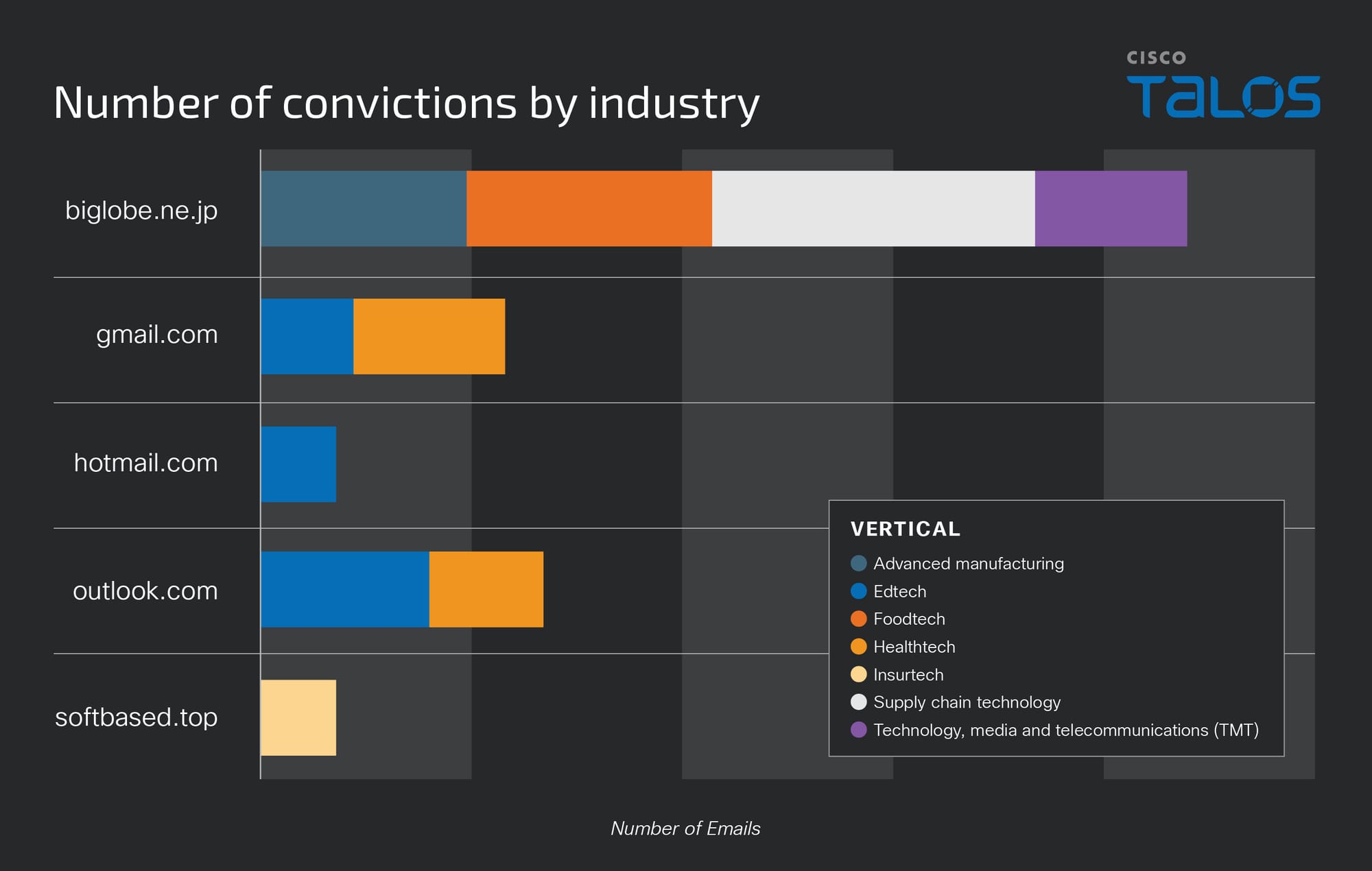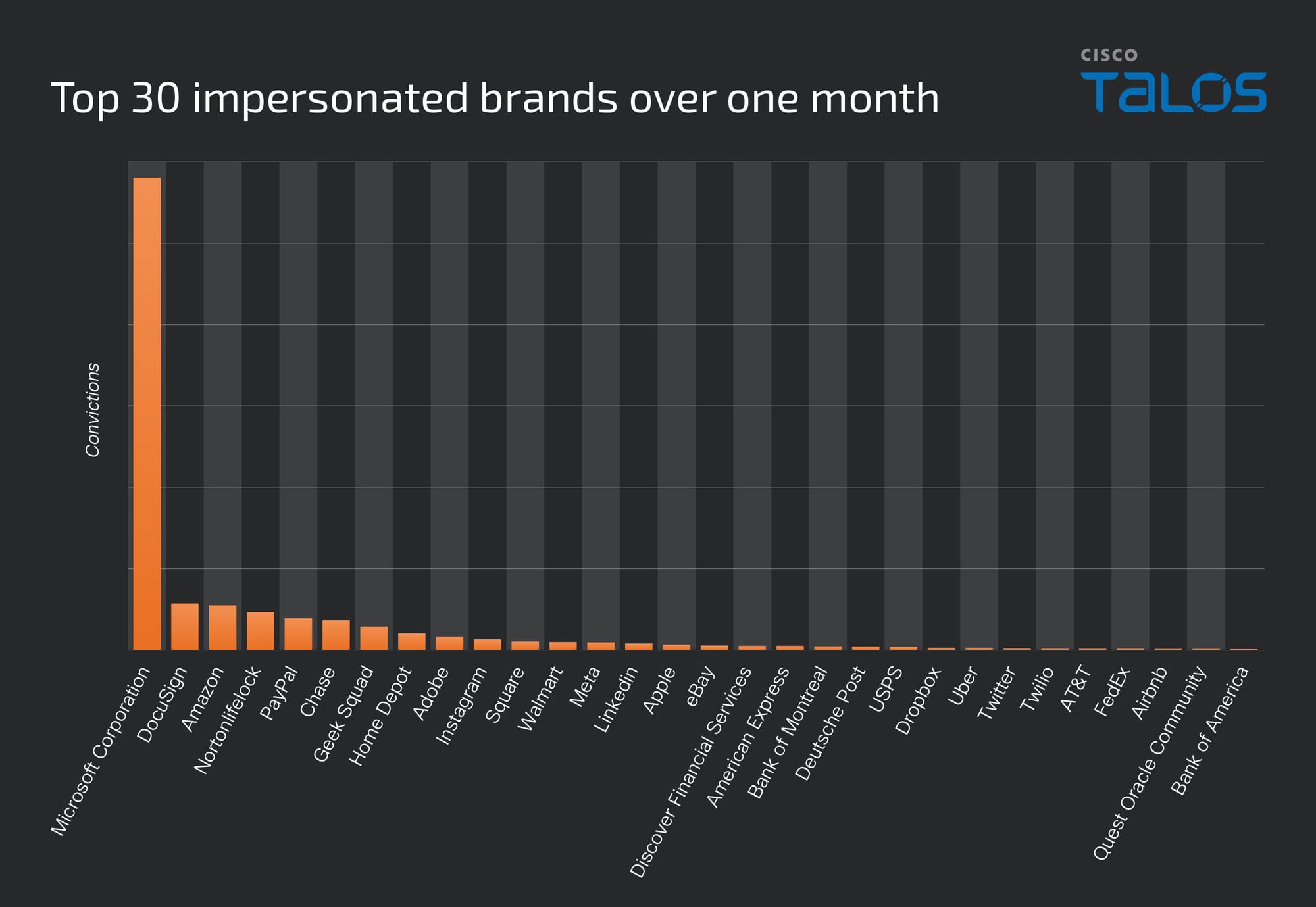- Cisco recently developed and released a new feature to detect brand impersonation in emails when adversaries pretend to be a legitimate corporation.
- Talos has discovered a wide range of techniques threat actors use to embed and deliver brand logos via emails to their victims.
- Talos is providing new statistics and insights into detected brand impersonation cases over one month (March - April 2024).
- In addition to deploying Cisco Secure Email, user education is key to detecting this type of threat.

Brand impersonation could happen on many online platforms, including social media, websites, emails and mobile applications. This type of threat exploits the familiarity and legitimacy of popular brand logos to solicit sensitive information from victims. In the context of email security, brand impersonation is commonly observed in phishing emails. Threat actors want to deceive their victims into giving up their credentials or other sensitive information by abusing the popularity of well-known brands.
Brand logo embedding and delivery techniques
Threat actors employ a variety of techniques to embed brand logos within emails. One simple method involves inserting words associated with the brand into the HTML source of the email. In the example below, the PayPal logo can be found in plaintext in the HTML source of this email.


Sometimes, the email body is base64-encoded to make their detection harder. The base64-encoded snippet of an email body is shown below.


The decoded HTML code is shown in the figure below. In this case, the Microsoft logo has been built via an HTML 2x2 table with four cells and various background colors.

A more advanced technique is to fetch the brand logo from remote servers at delivery time. In this technique, the URI of the resource is embedded in the HTML source of the email, either in plain text or Base64-encoded. The logo in the example below is fetched from the below address:
hxxps://image[.]member.americanexpress[.]com/.../AMXIMG_250x250_amex_logo.jpg


Another technique threat actors use is to deliver the brand logo via attachments. One of the most common techniques is to only include the brand logo as an image attachment. In this case, the logo is normally base64-encoded to evade detection. Email clients automatically fetch and render these logos if they’re referenced from the HTML source of the email. In this example, the Microsoft logo is attached to this email as a PNG file and referenced in an <img> HTML tag.


In other cases, the whole email body, including the brand logo, is attached as an image to the email and is shown to the victim by the email client. The example below is a brand impersonation case where the whole body is included in the PNG attachment, named “shark.png”. Also, an “inline” keyword can be seen in the HTML source of this email. When Content-Disposition is set to "inline," it indicates that the attached content should be displayed within the body of the email itself, rather than being treated as a downloadable attachment.


A brand logo may also be embedded within a PDF attachment. In the example shown below, the whole email body is included in a PDF attachment. This email is a QR code phishing email that is also impersonating the Bluebeam brand.


The scope of brand impersonation
An efficient brand impersonation detection engine plays a key role in an email security product. The extracted information from correctly convicted emails is valuable for threat researchers and customers. Using Cisco Secure Email Threat Defense’s brand impersonation detection engine, we uncovered the true scope of how widespread these attacks are. All data reflects the period between March 22 and April 22, 2024.
Threat researchers can use this information to block future attacks, potentially based on the sender’s email address and domain, the originating IP addresses of brand impersonation attacks, their attachments, the URLs found from such emails, and even phone numbers.
The chart below demonstrates the top sender domains of emails curated by attackers to convince the victims to call a number (i.e., as in Telephone-Oriented Attack Delivery) by impersonating the Best Buy Geek Squad, Norton and PayPal brands. Free email services are widely used by adversaries to send such emails. However, other domains can also be found that are less popular.

Sometimes, similar brand impersonation emails are sent from a wide range of domains. For example, as shown in the below heatmap, emails impersonating the DocuSign brand were sent from two different domains to our customers on March 28. In other cases, emails are sent from a single domain (e.g., emails impersonating Geek Squad and McAfee brands).

Brand impersonation emails may target specific industry verticals, or they might be sent indiscriminately. As shown in the chart below, four brand impersonation emails from hotmail.com and softbased.top domains were sent to our customers that would be categorized as either educational or insurance companies. On the other hand, emails from biglobe.ne.jp targeted a wider range of industry verticals.

Cisco customers can also benefit from information provided by the brand impersonation detection engine. By sharing the list of the most frequently impersonated brands with them regularly, they can train their employees to stay vigilant when they observe specific brands in emails.

Microsoft was the most frequently impersonated brand over the month we observed, followed by DocuSign. Most emails that contained these brands were fake SharePoint and DocuSign phishing messages. Two examples are provided below.

Other top frequently impersonated brands such as NortonLifeLock, PayPal, Chase, Geek Squad and Walmart were mostly seen in callback phishing messages. In this technique, the attackers include a phone number in the email and try to persuade recipients to call that number, thereby changing the communication channel away from email. From there, they may send another link to their victims to deliver different types of malware. The attackers normally do so by impersonating well-known and familiar brands. Two examples of such emails are provided below.

Protect against brand impersonation
Strengthening the weakest link
Humans are still the weakest link in cybersecurity. Therefore, educating users is of paramount importance to reduce the amount and effects of security breaches. Educating people does not only concern employees within a specific organization but in this case, it also involves their customers.
Employees should know an organization’s trusted partners and the way that their organization communicates with them. This way, when an anomaly occurs in that form of communication, they will be able to identify any issues faster. Customers need different communication methods that your organization would use to contact them. Also, they need to be provided with the type of information you will be asking for. When they know these two vital details, they will be less likely to share their sensitive information over abnormal communication platforms (e.g., through emails or text messages).
Brand impersonation techniques are evolving in terms of sophistication, and differentiating fake emails from legitimate ones by a human or even a security researcher demands more time and effort. Therefore, more advanced techniques are required to detect these types of threats.
Asset protection
Well-known brands can protect themselves from this type of threat through asset protection as well. Domain names can be registered with various extensions to thwart threat actors attempting to use similar domains for malicious purposes. The other crucial step brands can take is to conceal their information from WHOIS records via privacy protection. Last, but not least, domain names need to be updated regularly since expired domains can be easily abused by threat actors for illicit activities that can harm your business reputation. Brand names should be registered properly so that your organization can take legal action when a brand impersonation occurs.
Advanced detection methods
Detection methods can be improved to delay the exposure of users to the received emails. Machine learning has improved significantly over the past few years due to advancements in computing resources, the availability of data, and the introduction of new machine learning architectures. Machine learning-based security solutions can be leveraged to improve detection efficacy.
Cisco Talos relies on a wide range of systems to detect this type of threat and protect our customers, from rule-based engines to advanced ML-based systems. Learn more about Cisco Secure Email Threat Defense's new brand impersonation detection tools here.
from Cisco Talos Blog https://ift.tt/wYvdD4b
via IFTTT
No comments:
Post a Comment